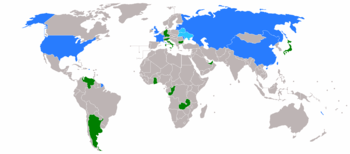1986 United Nations Security Council election
The 1986 United Nations Security Council election was held on 16 October 1986 during the Forty-first session of the United Nations General Assembly, held at United Nations Headquarters in New York City. The General Assembly elected Argentina, Italy, Japan, West Germany, and Zambia, as the five new non-permanent members of the UN Security Council for two-year mandates commencing on 1 January 1987.
| |||
5 (of 10) non-permanent seats on the United Nations Security Council | |||
|---|---|---|---|
|
| |||
 | |||
| |||
| Unsuccessful candidates |
Rules
The Security Council has 15 seats, filled by five permanent members and ten non-permanent members. Each year, half of the non-permanent members are elected for two-year terms.[1][2] A sitting member may not immediately run for re-election.[3]
In accordance with the rules whereby the ten non-permanent UNSC seats rotate among the various regional blocs into which UN member states traditionally divide themselves for voting and representation purposes,[4] the five available seats are allocated as follows:
- One for African countries (held by Madagascar)
- One for countries from the Asian Group (now called the Asia-Pacific Group[5]) (held by Japan)
- One for Latin America and the Caribbean (held by Trinidad and Tobago)
- Two for the Western European and Others Group (held by Australia and Denmark)
To be elected, a candidate must receive a two-thirds majority of those present and voting. If the vote is inconclusive after the first round, three rounds of restricted voting shall take place, followed by three rounds of unrestricted voting, and so on, until a result has been obtained. In restricted voting, only official candidates may be voted on, while in unrestricted voting, any member of the given regional group, with the exception of current Council members, may be voted on.
Endorsed candidates
Prior to the election, the Mexican delegate on behalf of the Latin American and Caribbean Group endorsed Argentina's candidacy, the West German delegate reiterated the Western European and Other Group's endorsement for Italy's candidacy as well as his country's, and the delegate of Senegal, speaking only for his own government, endorsed Zambia and clarified that his country's candidacy was for the following session.[6]
Result
Voting was conducted on a single ballot. Ballots containing more states from a certain region than seats allocated to that region were invalidated.
| Member | Round 1[6] |
|---|---|
| 154 | |
| 143 | |
| 143 | |
| 111 | |
| 107 | |
| 36 | |
| 16 | |
| 14 | |
| 3 | |
| 1 | |
| 1 | |
| 1 | |
| 1 | |
| 1 | |
| 1 | |
| 1 | |
| 1 | |
| 1 | |
| 1 | |
| 1 | |
| 1 | |
| abstentions | 0 |
| invalid ballots | 0 |
| required majority | 103 |
| ballot papers | 154 |
See also
References
- United Nations Security Council (2008), Repertoire of the practice of the Security Council, p. 178
- Conforti, Benedetto (2005), The law and practice of the United Nations, Martinus Nijhoff Publishers, p. 61
- Charter of the United Nations, Article 23
- Resolution 1991 A (XVIII), dated 1963-12-17, in force 1965-08-31.
- "Asian group of nations at UN changes its name to Asia-Pacific group", Radio New Zealand International, 2011-08-31.
- U.N. General Assembly, 41st session. Provisional Verbatim Record of Fortieth Meeting Held at Headquarters, New York, On Thursday, 16 October 1986. (A/41/PV.40) 17 October 1986
External links
- UN Document A/59/881 Note Verbale from the Permanent Mission of Costa Rica containing a record of Security Council elections up to 2004